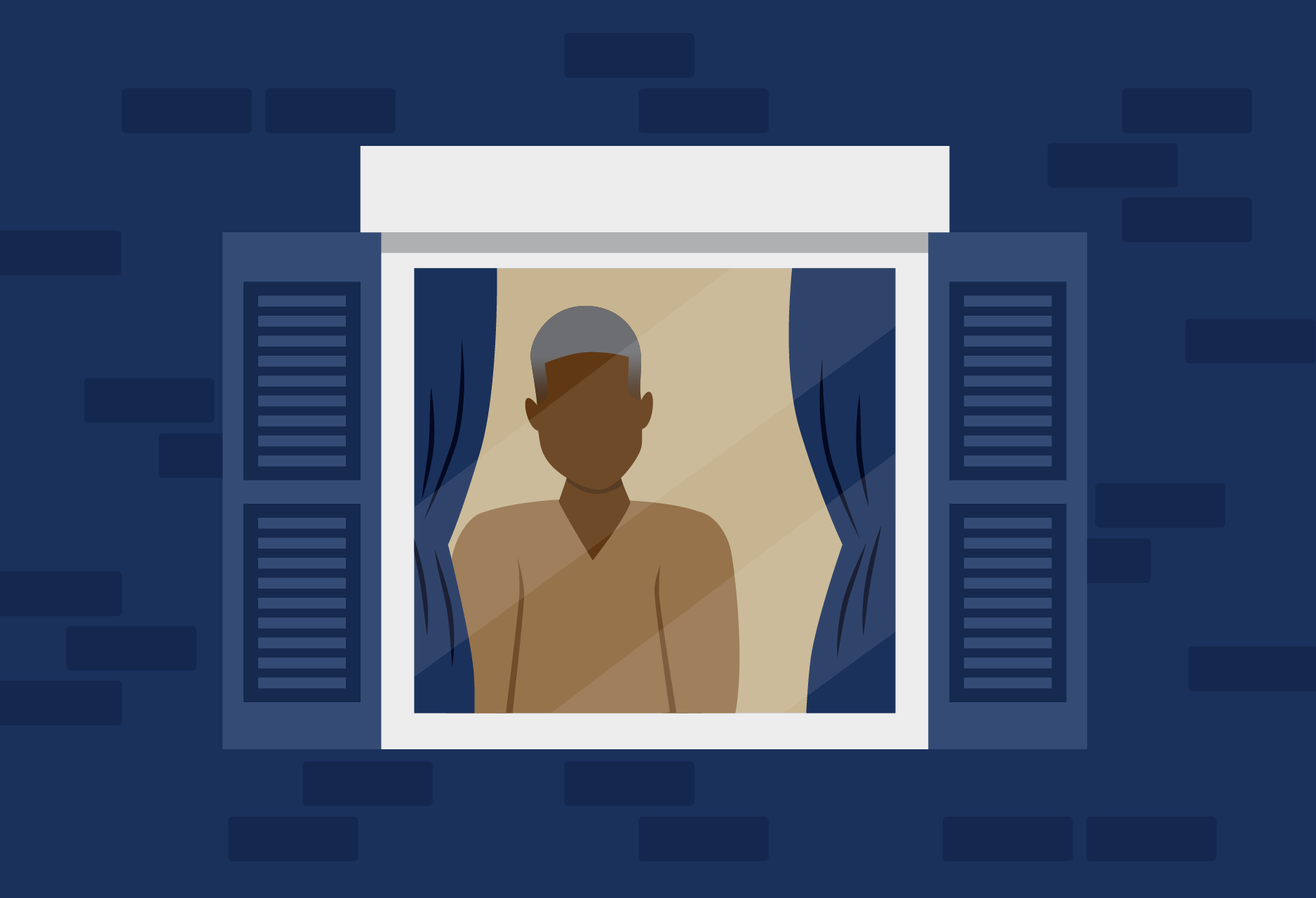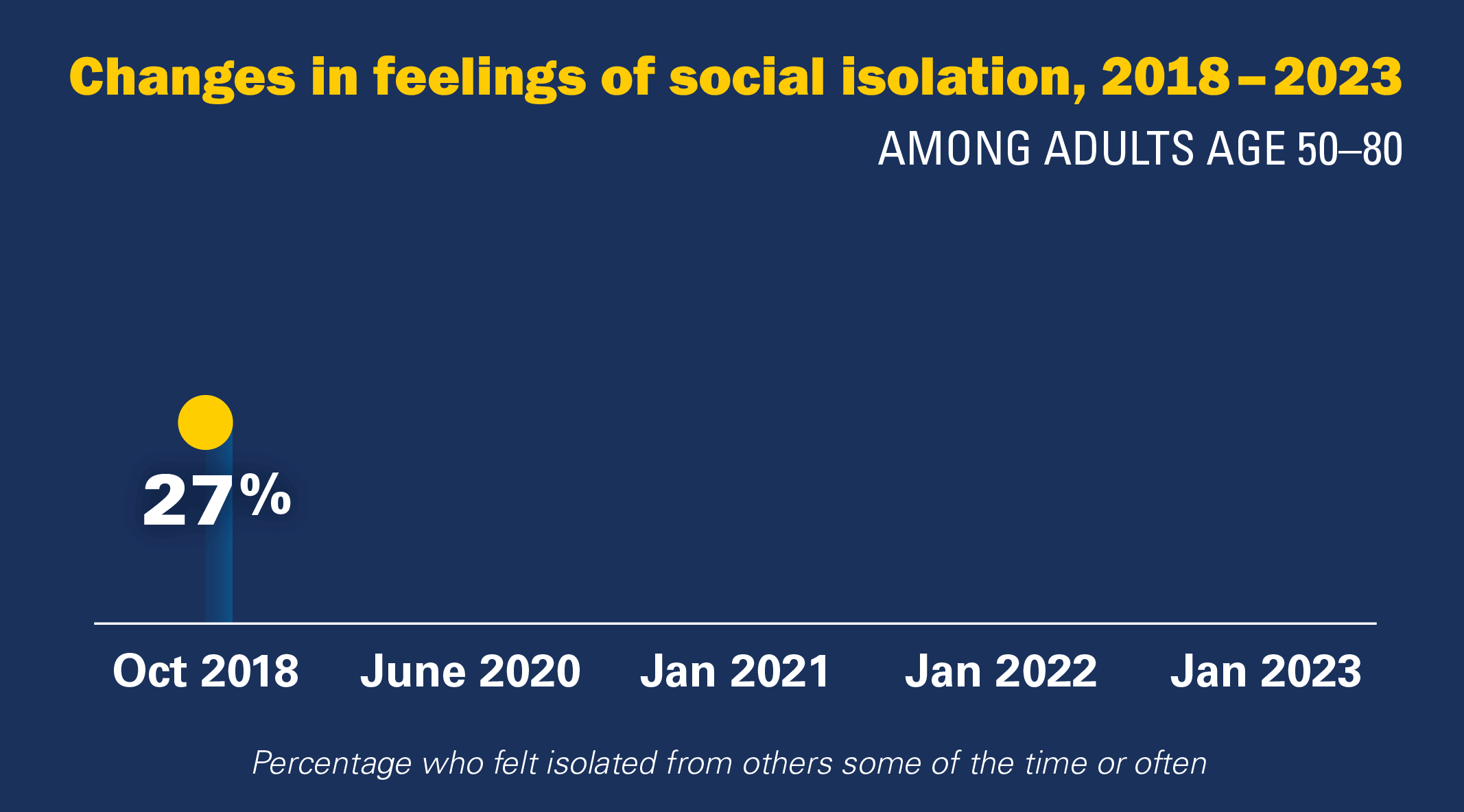
In January 2023, the University of Michigan National Poll on Healthy Aging (NPHA) asked a national sample of U.S. adults age 50–80 questions about loneliness (measured by their feelings of isolation and lack of companionship) and their social interactions. The NPHA asked the same questions to other similarly aged national samples of U.S. adults for reports in 2018 and 2020 and also included these questions in polls during 2021 and 2022.
The previous NPHA reports demonstrated that prior to the COVID-19 pandemic, a large portion of older adults experienced loneliness and infrequent social contact, and that those measures increased during the early months of the pandemic. This report presents findings from early 2023 with comparisons to prior surveys to describe trends in loneliness and social interactions among adults age 50–80 before and during the pandemic.
Measures of loneliness and social contact over time
In 2023, one in three adults age 50–80 (34%) reported feeling isolated from others (29% some of the time, 5% often) in the past year. This represents a marked decline compared with the 56% (43% some of the time, 13% often) who felt isolated in 2020, but a greater proportion than the 27% (22% some of the time, 5% often) who reported feeling isolated in 2018.
More than one in three older adults (37%) reported feeling a lack of companionship (29% some of the time, 8% often) in the past year, compared with 41% (32% some of the time, 9% often) in 2020, and 34% (26% some of the time, 8% often) in 2018.
One in three older adults (33%) reported infrequent contact (once a week or less) with people from outside their home in 2023 (14% once a week, 10% every 2–3 weeks, 9% once a month or less). This rate of infrequent contact was significantly less than the 46% reported in 2020 (19% once a week, 11% every 2–3 weeks, 16% once a month or less), but higher than the 28% reported in 2018 (15% once a week, 7% every 2–3 weeks, 6% once a month or less).

Feeling socially isolated
Feeling isolated from others some of the time or often in the past year was more common for those who reported fair or poor mental health (77% vs. 29% of those reporting excellent, very good, or good mental health), fair or poor physical health (55% vs. 29% of those reporting better physical health), and those with a health problem or disability that limits daily activities (51% vs. 26% of those without such limitations). Feelings of isolation were also more common among those who were not working/unemployed (51% vs. 29% of those employed or retired), people who lived alone (38% vs. 32% of those who lived with others), those age 50–64 (37% vs. 29% of those age 65–80), and women (37% vs. 31% of men).
Feeling a lack of companionship
Feeling a lack of companionship some of the time or often in the past year was more common among those who reported fair or poor mental health (73% vs. 33% of those reporting better mental health), fair or poor physical health (55% vs. 33% of those reporting better physical health), or having a health problem or disability that limits daily activities (51% vs. 30% of those without such limitations). Lack of companionship was also more common among those who were not working/unemployed (50% vs. 34% of those employed or retired), people who lived alone (47% vs. 33% who lived with others), those with annual household incomes less than $60,000 (43% vs. 31% of those with higher incomes), those age 50–64 (40% vs. 34% of those age 65-80), and women (40% vs. 34% of men).
Infrequent social contact
Infrequent contact with people from outside one’s household in the past year was more common among those who reported fair or poor mental health (56% vs. 30% of those with better mental health) or physical health (41% vs. 31% of those with better physical health), having a health problem or disability that limits daily activities (39% vs. 30% of those without such limitations), and men (37% vs. 29% of women).
Implications
Chronic loneliness (persistent feelings of isolation and/or a lack of companionship) can adversely affect mental, cognitive, and physical health, general well-being, and even longevity. NPHA polls from 2018 to 2023 have consistently found that feeling isolated from others, feeling a lack of companionship, and having infrequent social contact were strongly associated with poorer physical and mental health among older adults.
The results of this poll show that for adults age 50–80, lack of companionship and infrequent contact with family, friends, or neighbors outside the home have decreased to close to 2018 levels, although those pre-pandemic rates were already notably high. While the proportion of older adults who felt isolated from others in the past year is now lower than in the first three months of the pandemic, a substantial number still report feeling socially isolated.
Measures of loneliness remain particularly high among those with poorer physical and mental health, a health problem or disability that limits daily activities, and those who are not working/unemployed, live alone, are age 50–64, and women. People age 50–80 more likely to have limited social contact include those with fair or poor physical or mental health, an activity-limiting health problem or disability, and men.
Particularly notable are the high rates of measures of loneliness in 2023 among older adults with fair or poor physical health and mental health. Feelings of social isolation and lack of companionship were reported by more than seven in ten with fair or poor mental health and more than half of those with fair or poor physical health. In fact, measures of loneliness among those with fair or poor mental health were slightly higher in 2023 compared with the early months of the pandemic in 2020.
Addressing loneliness requires a multifaceted approach. Much like asking about diet and exercise, clinicians should identify and screen older adults at increased risk of feeling isolated, lacking companionship, or being disconnected from others. Individuals could be referred to Area Agencies on Aging and other community resources, such as senior centers or local libraries, which may help address unmet social needs, including opportunities for social connection. Family members and friends are encouraged to check in and reconnect with older friends and neighbors with whom they may have had limited contact during the past few years.
Loneliness affects the health and well-being of older adults. It is critical for policymakers, clinicians, and family members to address what the U.S. Surgeon General has called an “epidemic of loneliness.”
Data Source and Methods
This National Poll on Healthy Aging report presents findings from a nationally representative household survey conducted exclusively by NORC at the University of Chicago for the University of Michigan’s Institute for Healthcare Policy and Innovation. National Poll on Healthy Aging surveys are conducted using NORC’s AmeriSpeak probability based panel. This survey module was administered online and via phone in January 2023 to a randomly selected, stratified group of U.S. adults age 50–80 (n=2,563). The sample was subsequently weighted to reflect population figures from the U.S. Census Bureau. The completion rate was 61% among panel members contacted to participate. The margin of error is ±1 to 3 percentage points for questions asked of the full sample and higher among subgroups.
Findings from the National Poll on Healthy Aging do not represent the opinions of the University of Michigan. The University of Michigan reserves all rights over this material.
Read other National Poll on Healthy Aging reports and about our Michigan findings, and learn about the poll methodology.
Citation
Malani P, Singer D, Kirch M, Solway E, Roberts S, Smith E, Hutchens L, Kullgren J. Trends in Loneliness Among Older Adults from 2018-2023. University of Michigan National Poll on Healthy Aging. March 2023. Available at: https://dx.doi.org/10.7302/7011
Related Publication
Gerlach LB, Solway ES, Malani PN. Social isolation and loneliness in older adults. JAMA. Published online May 23, 2024. doi:10.1001/jama.2024.3456